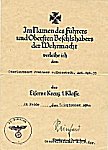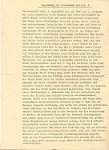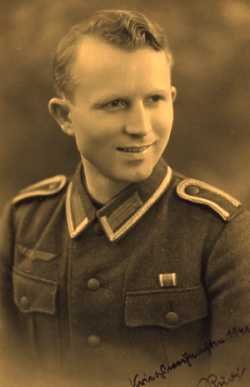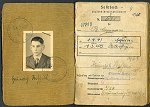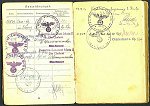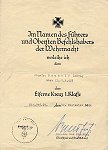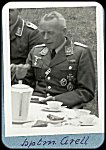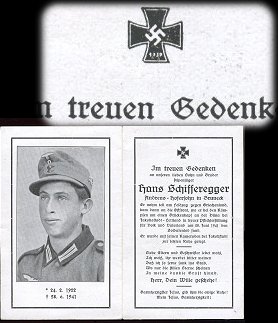
by Sebastián J. Bianchi
A German military clerk sits inside a field tent in the endless plains of Russia one hot summer day in 1942. A typewriter stares at him from a rickety wooden table. The cloth doors are tied open just enough to let some air in, but the tent is still in twilight, and filled with the smoke of his cigarette. He takes one last drag and puts it out on the ashtray next to the pile of blank documents before turning back to his task. He will never know that his key strokes will be scrutinized more than a half a century later, to him this is routine and quite frankly, mundane. To this man the names he types are inconsequential, but he is giving them a chance at posterity, since the ink slamming onto those papers is marrying the names its spells out to a legendary military decoration; the Iron Cross.
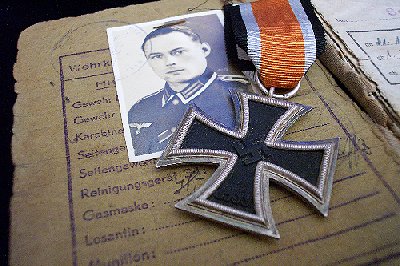
Papers and documents of the era carry a large burden in telling the story of the cross because a name and often a face is attached to the powerful but anonymous Iron Cross. Very often a whole story is told via these documents, and those that dig and research can unearth small treasures of human interest.
The second and first class of Iron Cross, as well as both the clasps to the 1914 Crosses, were accompanied by an entitlement document and proper annotations in the personal documents of the recipient (Wehrpass and Soldbuch). There was only one official entitlement document for the 1st and 2nd Class, though details vary depending on the date and Military branch.
One of the most notable variations is that the documents were written in gothic up until 1943, at which point the font switched over to Latin script. In addition to "early" and "late" documents, which themselves have various small variations that are to be expected due to the numbers awarded, there are those that were field made or improvised - a variation which is rare and difficult to authenticate.
Still, all types follow the general outline; Issued in the name of the Führer and the Wehrmacht high command it has on the front the name, rank, unit, and grade of the cross awarded. Most times the personal details of the recipient were typed, but they can also be found written in neat calligraphy. The authorizing signature was on the bottom right and on the left bottom was the corresponding stamp. There was no explanation in any Class of the actions that merited the award on the actual documents, these are found on the recommendation letter. Pictured below are examples of two typical Iron Cross documents of the kind that researchers and collectors are most likely to encounter.
Click on images to enlarge
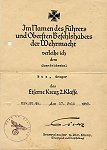 |
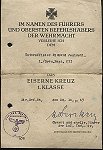 |
|
Comparison of an early (left) and late (right) standard Iron Cross documents. Angel Farré (L), Sebastian Bianchi (R) |
|
As previously mentioned in addition to the document an entry was made into the soldier's Wehrpass, Soldbuch, and any other relevant document. The annotation in the Wehrpass/Soldbuch could be either spelled out "Eiserne Kreuz 2 Klasse" or abbreviated into "E.K. II kl", and it was entered on page 22 of the Soldbuch and page 21, 23, and 25 of the Wehrpass.
Other documents encountered that are related to the first two classes of the Iron Cross include congratulatory telegrams sent to the recipients and letters of recommendation for the award, which as previously mentioned include the deeds performed to deserve the cross and thus make for very interesting reading.
Iron Cross first
class document for Hauptmann von Kniestedt ( DKiG on January 15th,
1942), and the letter of proposition for same.
Angel Farré Collection |
|
Iron Cross 2nd class
citation (left) and entry into Wehrpass (right). Kreiger,
Obergefreiter, Inf Regt 105 (72 ID).
Gary Tankard Collection |
|
Unteroffizier Kleinsteuber, Pz. Gren. Regt. 113 (1 Pz Div) - award of EK 1,
typed (left). Not entered in wehrpass as it was
awarded posthumously, but Iron Cross 2nd Class entry (right).
Gary Tankard Collection |
|
Langemeyer - Feldwebel,
Inf Regt 184 (86 ID), 1st Class (left). On right Feldwebel Kinsch, Inf. Regt. 120 (mot) (60 Inf.
(mot)) - awarded the EK 1, EK 2 and Silver Wound Badge on same
day. Was severely wounded the previous month.
Gary Tankard Collection |
|
|
|
|

|
|

|
|
Unteriffuzier
Rudolf Hillebrand. Bottom left is his official document,
and on the right are the entries into this wehrpass for the Iron
Cross 1st Class and the 2nd Class.
Gary Tankard Collection |
|
|
|
Obergefreiter
Ludwig Neumair.. The documents to the Iron Cross first class (bottom left) and the entries into his soldbuch (bottom right). Angel Farré Collection
|
|
 |
||
Spange to the Iron Cross 1914 Documents
In addition to the documents presented above, it can be said that the Iron Cross is the only decoration that was routinely and prominently pictured in the obituary of a fallen soldier.
|
Sebastian Bianchi Collection |
© Copyright Wehrmacht-Awards.com LLC |
